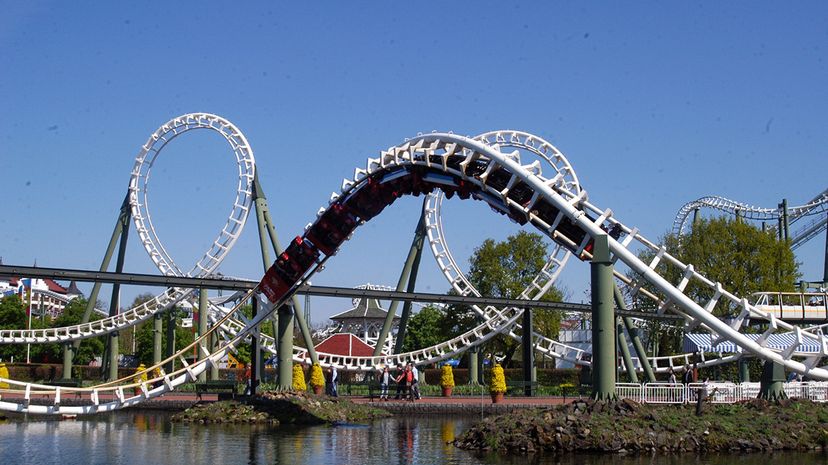Loop-the-Loops

As you go around a loop-the-loop, your inertia not only produces an exciting acceleration force, but it also keeps you in the seat when you're upside down.
A roller coaster loop-the-loop is a sort of centrifuge, just like a merry-go-round. In a merry-go-round, the spinning platform pushes you out in a straight line away from the platform. The constraining bar at the edge of the merry-go-round stops you from following this path — it is constantly accelerating you toward the center of the platform.
Advertisement
The loop-the-loop in a roller coaster acts the same as a merry-go-round. As the train cars approach the loop, your inertial velocity is straight ahead of you. But the track keeps the coaster car, and therefore your body, from traveling along this straight path. The force of your acceleration pushes you from the coaster-car floor, and your inertia pushes you into the car floor. Your own outward inertia creates a sort of false gravity that stays fixed at the bottom of the car even when you're upside down. You need a safety harness for security, but in most loop-the-loops, you would stay in the car whether you had a harness or not.
As the cars move through the loop, the net force acting on your body is constantly changing. At the very bottom of the loop, the acceleration force is pushing you down in the same direction as gravity. Since both forces push you in the same direction, you feel especially heavy at this point. As you move straight up the loop, gravity is pulling you into your seat while the acceleration force is pushing you into the floor. You feel the gravity pulling you into your seat, but (if your eyes are still open) you can see that the ground is no longer where it should be.
At the top of the loop, when you're completely upside down, gravity is pulling you out of your seat, toward the ground, but the stronger acceleration force is pushing you into your seat, toward the sky. Since the two forces pushing you in opposite directions are nearly equal, your body feels very light. As in the sharp descent, you are almost weightless for the brief moment when you are at the top of the loop.
As you come out of the loop and level out, you become heavy again. The loop-the-loop is amazing because it crams so much into such a short length of track. The varying forces put your body through the whole range of sensations in a matter of seconds. While these forces are shaking up all the parts of your body, your eyes see the entire world flip upside down. To many coaster riders, this moment at the top of the loop, when you're light as a feather and all you can see is the sky, is the best part of the whole ride.
In a loop-the-loop, the intensity of the acceleration force is determined by two factors: the speed of the train and the angle of the turn. As the train enters the loop, it has maximum kinetic energy — that is, it is moving at top speed. At the top of the loop, gravity has slowed the train down somewhat, so it has more potential energy and less kinetic energy — it is moving at reduced speed.
Originally, roller-coaster designers made circle-shaped loops. In this design, the angle of the turn is constant all the way around. In order to build an acceleration force strong enough to push the train into the track at the top of the loop, they had to send the train into the loop at a fairly high rate of speed (so it would still be going pretty fast at the top of the loop). Greater speed meant a much greater force on the rider as he entered the loop, which could be fairly uncomfortable.
The teardrop design makes it much easier to balance these forces. The turn is much sharper at the very top of the loop than it is along the sides. This way, you can send the train through the loop fast enough that it has an adequate acceleration force at the top of the loop, while the teardrop shape creates a reduced acceleration force along the sides. This gives you the force you need to keep everything running, without applying too much force where it might be dangerous.